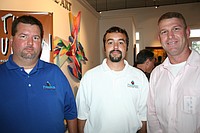As we celebrate Ireland and all things Irish this St Patrick's Day, there is no better time to reflect on the Irish contribution to the wider world. Here is a sneak peek at a few of those included my new book, "What have the Irish ever done for us?" from Currach Books. It details achievements and contributions by Irish people all around the world and features illustrations by Alba Esteban.
Photo Gallery
NLR Business After Hours
Greg Thompson Fine Art Gallery filled with networking professionals during Business After Hours hosted by North Little Rock Chamber of Commerce.
John Boyd Dunlop and William Harvey Du Cros
It was a Belfast vet named John Boyd Dunlop and a Dublin cycling enthusiast named William Harvey du Cros who came up with the innovation that would make the age of the motorcar possible. Dunlop created an early pneumatic tire to make his son's bone-shaking tricycle rides along the cobbled streets of Belfast more comfortable. The design was soon taken up by racing cyclists, where Du Cros first spotted it. He took Dunlop's idea global with Dunlop Rubber Co.
John Holland
As unlikely as it may seem, the modern submarine is indeed an Irish invention, developed by the talented John P. Holland from Liscannor in County Clare. The U.S. Navy purchased Holland's design in 1900, where the USS Holland became the first commissioned submarine in history. Its success led to other navies also purchasing the designs, including Japan and the United Kingdom, where five "Holland Class" submarines were commissioned.
James Martin
Engineer James Martin from Crossgar in County Down made the first successful test of an aircraft ejector seat in January 1945 when Bernard Lynch successfully ejected. The Martin-Baker ejector seat went into production soon afterwards and to date has saved more than seven thousand lives around the world.
Samuel O'Reilly
Inventive tattoo artist Samuel O'Reilly did much more than come up with artistic tattoo designs. It was O'Reilly who patented the first electric tattoo machine in New York in 1891. O'Reilly's invention made tattooing much safer, much quicker and cheaper to do. Without him the modern popularity of tattooing would not have been possible.
Cynthia Longfield
Cork woman Cynthia Longfield became known as "Madame Dragonfly" thanks to her adventurous career as a globetrotting entomologist. She collected specimens all around the world, discovering several new species and became a leading authority on dragonflies. She became an honorary associate of the Natural History Museum in London, where much of her work is catalogued.
Eileen Marie Collins
Proud Irish-American Eileen Marie Collins became the first female space shuttle commander aboard the space shuttle Columbia in 1999. Eileen also piloted the space shuttle Discovery in 1995 and the Atlantis in 1997. During her final mission in 2005 on Discovery, she became the first pilot to maneuver a shuttle through a 360-degree roll.
Ninette de Valois
Ninette de Valois was the stage name of Edris Stannus from Blessington, County Wicklow. When injury cut her career as a ballet dancer short, she formed her own ballet company, performing in Dublin and London. The company she formed at the Sadler's Wells theater in London would become England's national ballet company, the Royal Ballet.
Jim Fitzpatrick
An image created by Irish artist Jim Fitzpatrick in 1968 is among the most recognized by any artist from any era. The black-on-red image of Che Guevara's face has since become one of the most recognized images in the world, a symbol of protest and rebellion, and now appears on everything from mugs to posters and T-shirts.
Bram Stoker
Dublin-born writer Bram Stoker will forever be remembered for writing Dracula, first published in 1897. It was immediately successful and has continued to grow in popularity ever since its publication. Dracula has become the most successful horror novel in history and one of the most adapted and influential works of any genre.
Nellie Bly
Irish-American Elizabeth Cochran Seaman, better known by her pen name of Nellie Bly, was a pioneering investigative reporter. She became world-famous in 1889 when she successfully embarked on a round-the-world trip with the aim of beating the fictitious Around the World in Eighty Days achieved by Phileas Fogg.


